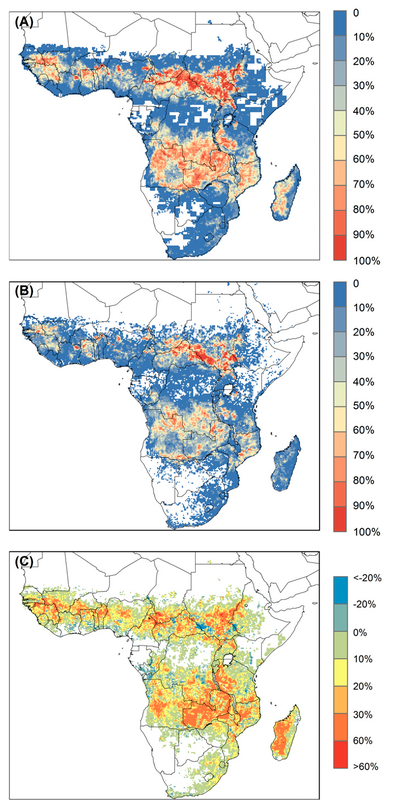March 15, 2021
African burned area and emissions much larger than thought
Satellite study highlights importance of small fires and their carbon emissions
The area of sub-Saharan Africa’s land surface affected by fire is 80% higher than previously thought, according to a new satellite study published in PNAS. Given that Africa accounts for the vast majority of global burned area, this new finding has implications for global fire carbon emissions, which the authors calculated to be up to twice as high as previously thought.
Fires are a major contributor to atmospheric budgets of greenhouse gases and aerosols, and are considered to be a key aspect of the climate by the Global Climate Observing System. Satellites are the preferred way to estimate large-scale patterns and trends of fire occurrence, and do so by detecting changes in surface reflectance of burned land surface area.

Lead authors Rubén Ramo and Emilio Chuvieco from the University of Alcalá and colleagues from the University of the Basque Country (Ekhi Roteta and Aitor Bastarrika) assembled and compared a new, fine resolution burned area dataset (FireCCISFD11) generated from the Copernicus Sentinel-2 satellite as part of the ESA Climate Change Initiative to investigate the patterns of burned area across Africa. With a footprint of 20 by 20 metres, the new data product made it possible to detect smaller fires compared to the 500 by 500 metre resolution of global products previously used to estimate fire occurrence.
The research team found that relatively small fires - which remain undetected in the coarse resolution datasets - are much more important than previously thought, contributing 2.02 million km2 of the 4.89 million km2 total burned area detected.
Africa was chosen for this study as it accounts for about 70% of global burned area and about half of global fire carbon emissions.
Carbon fire emissions
The corresponding fire carbon emissions from African fires were estimated by Vrije Universiteit Amsterdam researchers Ioannis Bistinas, Dave van Wees and Guido van der Werf. At 1.44 PgC, the new emissions estimates were 31–101% higher than previous thought. Representing 14% of global carbon dioxide emissions from fossil fuel burning, the increase is substantial and larger than total annual fire carbon emissions in South America.
The authors conclude that small fires are a critical driver of burned area in sub Saharan Africa and that including the newly detected small fires in emission estimates raises the contribution of biomass burning to global burdens of greenhouse gases and aerosols.
This product was developed under the European Space Agency’s FireCCI project, which aims to generate long term dataset products for a suite of Essential Climate Variables for Climate Change assessment.

